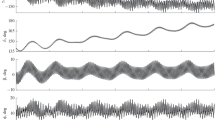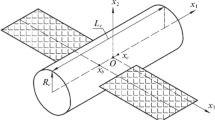Abstract—
The possibility of stabilizing the gravitational orientation mode of a massive artificial Earth satellite (AES) by the torque produced by electromagnets interacting with Earth’s magnetic field is shown. As an example, the control of rotational motion of the satellite like Bion M-1 and Foton M-4 is considered. Control is accomplished by changing the currents in the electromagnets. The control law is considered, which provides damping of the disturbed motion of a satellite and its stabilization in the gravitational orientation mode. To form this law, it is sufficient to have the readings of a triaxial magnetometer and of an angular velocity sensor. The control law efficiency is verified by mathematically modeling satellite motion relative to the center of masses, under an effect of gravitational and aerodynamic torques, as well as the torque produced by electromagnets.





Similar content being viewed by others
REFERENCES
Ignatov, A.I. and Sazonov, V.V., Realization of modes of satellite attitude motion with a small level of microaccelerations using electromechanical executive devices, Cosmic Res., 2012, vol. 50, no. 5, pp. 353–366.
Martel, F., Parimal, K., and Psiaki, M., Active magnetic control system for gravity gradient stabilized spacecraft, Annual AIAA/Utah State University Conference on Small Satellites, Washington, D.C.: AIAA, 1988, pp. 1–10.
Arduini, C. and Baiocco, P., Active magnetic damping attitude control for gravity gradient stabilized spacecraft, J. Guid. Control. Dyn., 1997, vol. 20, no. 1, pp. 117–122.
Wisniewski, R. and Blanke, M., Fully magnetic attitude control for spacecraft subject to gravity gradient, Automatica, 1999, vol. 35, pp. 1201–1214.
Beletskii, V.V., Dvizhenie iskusstvennogo sputnika otnositel’no tsentra mass (Artificial Satellite Motion Relative to Center of Mass), Moscow: Nauka, 1965.
Kovalenko, A.P., Magnitnye sistemy upravleniya kosmicheskimi letatel’nymi apparatami (Magnetic Systems of Spacecraft Control), Moscow: Mashinostroenie, 1975.
Krasovskii, N.N., Nekotorye zadachi teorii ustoichivosti dvizheniya (Some Problems in the Theory of Motion Stability), Moscow: Fizmatgiz, 1959.
Abrashkin, V.I., Puzin, Yu.A., and Sazonov, V.V., Electromagnetic attitude control system providing small residual accelerations onboard the spacecraft, Preprint of Keldysh Institute of Applied Mathematics, Russ. Acad. Sci., Moscow, 2010, no. 22.
Ignatov, A.I. and Sazonov, V.V., Stabilization of spacecraft in the gravity orientation mode by electromagnetic control system, Preprint of Keldysh Institute of Applied Mathematics, Russ. Acad. Sci., Moscow, 2016, no. 28.
Author information
Authors and Affiliations
Corresponding author
Additional information
Translated by Yu. Preobrazhensky
Rights and permissions
About this article
Cite this article
Ignatov, A.I., Sazonov, V.V. Stabilization of the Gravitational Orientation Mode of an Artificial Earth Satellite (AES) by the Electromagnetic Control System. Cosmic Res 58, 33–41 (2020). https://doi.org/10.1134/S0010952520010037
Received:
Revised:
Accepted:
Published:
Issue Date:
DOI: https://doi.org/10.1134/S0010952520010037




